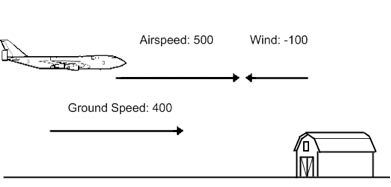Glossary of Aviation Terms | Ground Speed
Ground Speed | Paramount Business Jets
Ground speed is the actual speed that an aircraft travels over the ground and is also referred to as "shadow speed." Ground speed combines the aircraft’s airspeed and the wind speed relative to the aircraft’s direction of flight. An aircraft’s airspeed is determined not by how much distance it covers in a set time, but by a combination of its forward speed and the speed of the wind that is blowing towards the aircraft.
A wing must have air moving over it to create lift. Too little moving air and the airplane will "stall", or lose elevation very rapidly. The stall speed is when the wings no longer create lift and the airplane falls from the sky. As an example, let’s say that an aircraft has a stall speed of 20 knots. That does not mean that the aircraft needs to propel itself at 20 knots, but rather that the air moving over the wing must be traveling at 20 knots or more so that the aircraft can stay aloft. Therefore, a gust of wind that is traveling at 20 knots towards the aircraft will allow the airplane to hover stationary over an area.
Ground speed and airspeed are not always the same speed. On a windy day, an airplane may have an airspeed of 80 knots but a ground speed of only 60 knots. The term "shadow speed" comes from the speed of the airplane’s shadow on the ground. If an aircraft has an airspeed of 80 knots but a ground speed of 60 knots, a car that follows the shadow will only need to go 60 knots to keep the same speed as the airplane.
Most people have heard of headwinds and tailwinds. A tailwind will help push an aircraft faster so that it reaches its destination more quickly, while a headwind pushes against the aircraft and slows it down. A headwind will detract from an aircraft’s ground speed, while a tailwind will increase it.

Explore More Aviation Terminology
- Drag | Paramount Business Jets
- Block Speed | Paramount Business Jets
- Approach (Departure) Control | Paramount Business Jets
- Airworthiness Directive (AD) | Paramount Business Jets
- Waiting Time | Paramount Business Jets
- ARG/US | Paramount Business Jets
- Great Circle Distance | Paramount Business Jets
- EFIS | Paramount Business Jets
- Part 61 | Paramount Business Jets
